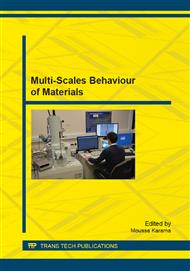[1]
JG. MacGregor,. Reinforced concrete: Mechanics and design. 3rd ed, 1997; 393.
Google Scholar
[2]
A. Noumowe , S. Aggoun, R. Cabrillac ., mechanical properties of lightweight aggregate concrete after exposure at high temperature.,. 2nd international symposium on structural lightweight aggregate concrete. kristiansand, norway. (2000).
DOI: 10.14359/4010
Google Scholar
[3]
M. -R. Samidi, first report research project on lightweight concrete, University Technology of Malaysia, Skudai, Johor Bahru.
Google Scholar
[4]
J. Laroze ., mécanique des structures tome 4 : calcul des structures en matériaux composites,. eyroles masson ed. (1988).
Google Scholar
[5]
I. Czarnecki, T. Broniewski., resin concrete and polymer impregnated concrete: a comparative study ,. compte rendu du third international congress on polymers in concrete, koriyama, japon, vol. 1, mai (1981).
Google Scholar
[6]
M.M. Khenfer, P. Morlier ., effect the length of fibers on the properties of cements reinforce fibers with cellulose, , journal of materials & constructions, vol. 24, pp.185-190, (1991).
Google Scholar
[7]
A . Ledhem., A. Bouguerra, M. Queneudec ., étude de l'influence des traitements des granulats et d'ajouts matriciels sur la stabilisation dimensionnelle d'un composite ciment bois fines, revue marocaine de génie civil, n°64, pp.63-67, juillet (1996).
Google Scholar
[8]
S. Aggoun, R. Cabrillac , study of the implementation of lightweight aggregate concretes using a high performance matrix, . international symposium on cement and concrete technology in the 2000 s. istambul, turkiye. (2000).
Google Scholar
[9]
P.R. L Helene, P.J.M. Monteiro., performance analysis of lightweight aggregate mortar., concret technolgy : new trends, industrial applications. Rilem international workschop. 1994-11-07, barcelona, (1995).
DOI: 10.1201/9781482271584-11
Google Scholar
[10]
M. -H. Zhang., o, Gjorv., mechanical propreties of high strength lightweight concrete, ACI materials journal, v. 88, n°3, may-june. (1991).
Google Scholar
[11]
J. Roberto dos Santos, F. Branco, J de Brito., 'mechanical propreties of concrete with coarse recycled aggregates. Structural Engineering International 3/2004, 213-215.
DOI: 10.2749/101686604777963900
Google Scholar
[12]
B. Gonzalez, F. Martinez., Shear strength of concrete with recycled aggregates. International RILEM Conference on the 'Use of recycled materials in Buildings and Structures, Barcelona, Spain 8-11 Nov. (2004).
Google Scholar
[13]
H. W. REINHARDT, Fracture mechanics of an elastic softening material like concrete, Heron, Vol. 29, No. 2, 1984, 42 pp.
Google Scholar
[14]
A. HILLERBORG, Analysis of fracture by means of the fictitious crack model particularly for fibre reinforced concrete, Int. Journal of Cement Composites, 2, 1980, pp.177-184.
DOI: 10.1016/0010-4361(81)90517-6
Google Scholar


